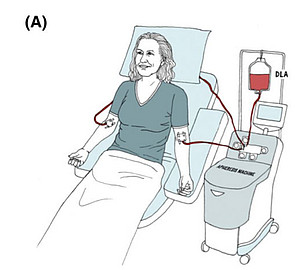Diagnostische Leukapherese (DLA)
Die Flüssigbiopsie ist eine nicht-invasive Methode zur Sammlung von zirkulierendem Tumormaterial aus Körperflüssigkeiten z.B. Blut. Zirkulierende Tumorzellen (CTCs) sind Zellen, die vom Primärtumor oder einer Metastase freigesetzt werden und im Blutkreislauf durch den Körper transportiert werden. Dies bedeutet, dass sie auch nach der Entfernung des Primärtumors/Metastase weiter zirkulieren können. CTCs gelten als Auslöser für die Bildung weiterer Metastasen in entfernten Organen viele Jahre nach der ersten Diagnose. Daher ist es entscheidend, CTCs zur Krankheitsprognose und Therapieentscheidung zu analysieren. Die Untersuchung der patientenspezifischen CTCs ermöglicht auch die frühzeitige Erkennung eines möglichen Rückfalls und die Anpassung einer effektiveren personalisierten Therapie, indem das therapeutische Ansprechen oder die Entstehung eines therapieresistenten Tumorherdes oder Metastase überwacht wird.
Eine Herausforderung bei der Gewinnung von CTCs besteht darin, dass ihre Anzahl bei einer normalen Entnahme von etwa 10 mL Blut extrem niedrig ist. Um dieses Problem zu überwinden und die Ausbeute von CTCs zu erhöhen, setzen wir am Universitätsklinikum Düsseldorf eine Leukapherese-Methode ein. Diese sogenannte „diagnostische Leukapherese“ (DLA) nutzt eine seit einigen Jahrzehnten etablierte Standardmethode zur Anreicherung der mononukleären Zellen (MNCs) aus dem Blut. Es handelt sich dabei um eine dichtebasierte Zellseparationstechnik, die Zellen einer bestimmten Dichte aus dem Blut abtrennt. Da CTCs eine zu den MNCs vergleichbare Dichte besitzen, werden sie mit angereichert. Der Vorteil der DLA ist, das mit ihr größere Blutvolumina (bis zum gesamten Blutvolumen eines Menschen von etwa 5 L) prozessiert werden können, wodurch wir je nach Situation und Patientin 200-mal mehr CTCs als bei einer normalen Blutentnahme gewinnen können. Die DLA wurde an Brustkrebspatientinnen getestet und hat sich als gut verträglich ohne Nebenwirkungen bei den Patienten erwiesen.

Fehm et al, 2018, Cytometry Part A
Veröffentlichungen/Publications:
1) Diagnostic leukapheresis enables reliable detection of circulating tumor cells of nonmetastatic cancer patients
https://pubmed.ncbi.nlm.nih.gov/24065821/
2) Diagnostic leukapheresis for CTC analysis in breast cancer patients: CTC frequency, clinical experiences and recommendations for standardized reporting
https://pubmed.ncbi.nlm.nih.gov/30551262/
3) Label-Free Enrichment and Molecular Characterization of Viable Circulating Tumor Cells from Diagnostic Leukapheresis Products
https://pubmed.ncbi.nlm.nih.gov/30737205/
4) Diagnostic Leukapheresis Enables Reliable Transcriptomic Profiling of Single Circulating Tumor Cells to Characterize Inter-Cellular Heterogeneity in Terms of Endocrine Resistance
https://pubmed.ncbi.nlm.nih.gov/31261643/
5) Multiparametric Circulating Tumor Cell Analysis to Select Targeted Therapies for Breast Cancer Patients
https://pubmed.ncbi.nlm.nih.gov/34885114/
Ansprechpartner:
Studienzentrale der Frauenklinik
Institut für Transplantationsdiagnostik und Zelltherapeutika (ITZ)
Diagnostic Leukapheresis
Liquid biopsy is a non-invasive method to collect circulating cancer material from body fluids, such as blood. Circulating tumor cells (CTCs) are cells that are released from the primary tumor and travel in the bloodstream, meaning that they continue circulating even after the removal of the primary tumor. CTCs are shown to be the drivers of metastatic formation in distant organs many years after the first diagnosis. Therefore, it is crucial to analyze CTCs for disease prognosis and therapy decision making. Examination of the patient-specific CTCs also enables the detection of a possible recurrence at an early stage and tailoring a more effective personalized therapy by monitoring therapeutic response and resistance.
One challenge of harvesting CTCs is that the number of CTCs is extremely low in a normal blood draw due to blood volume. To overcome this problem and to increase the yield of CTCs, we are using a leukapheresis method. Diagnostic leukapheresis (DLA) is a standard method to enrich mononuclear cells from blood for many applications in the clinic. It is a density-based cell separation technique that collects mononuclear cells together with the CTCs as they share similar densities. DLA enables surveying larger volumes of blood (up to several liters compared to 10 ml in a blood draw), and therefore captures 200-fold more CTCs. The method is validated in breast cancer patients and shown to be well-tolerated by the patients with no side effects.


